The New Normal: The Post-COVID Office Is More Agile Than Ever
America is getting back to work. With the vaccine rolling out, many are now returning to the office. But it isn’t the office as we knew it.
To understand why and how the workplace will change, we should first look at the fallout from the pandemic, a time when offices were shuttered across Vermont and across the country.
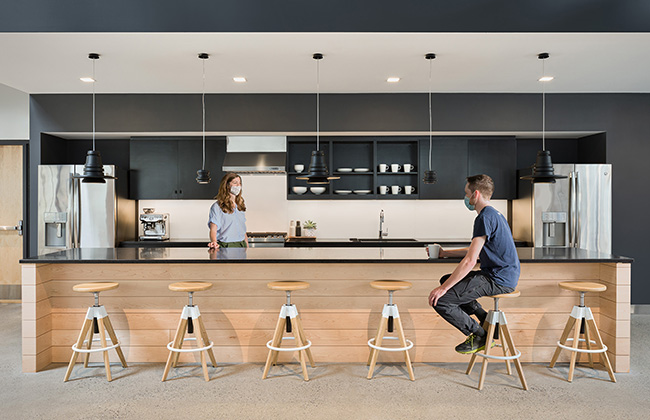
A YEAR OF CHANGE
Our collective experience with working from home has been a mixed bag.
For many, productivity actually increased during the pandemic. While working from home, employees controlled their own day, focused on specific tasks, and eliminated their daily commute. For years, employers had resisted the trend toward remote working, but the experience of the pandemic cracked the myth that workers needed to be in the office to be productive.
But employees who are more productive are not necessarily more engaged.
The prolonged isolation of working from home deprived us of the in-person collaboration that is critical to our well-being. We made great strides with digital tools, but Zoom calls and email can not replace the critical subtleties of a face-to-face conversation.
The pandemic-induced isolation exacerbated social and gender inequities in the workplace as well. Women were disproportionately affected by school closures and childcare issues, and younger workers were deprived of the in-person mentoring and learning that is critical to upward growth.
So, while it’s clear there are some aspects of remote work many find preferable – flexible hours and no commute – it’s also true that a fully remote working environment is not for everyone. A physical return to the office is necessary for in-person collaboration, to provide a more equitable workplace, and to alleviate the emotional stress of social isolation.
The question is, how can a company support a safe return to the office while maintaining the efficiencies and benefits of working-from-home that everyone grew accustomed to?
THE FUTURE IS FLEXIBLE
The key to a safe return to the office is flexibility. Increased flexibility in the workplace has been increasing for the past few years, but the unique challenges of the pandemic have accelerated this trend.
A flexible workplace is often defined as one in which employees have the flexibility to choose their own hours, with the freedom to come and go as needed. This will be more prevalent in the post-pandemic workplace. When it comes to returning to the office, many workers who have been working from home have expressed interest in a hybrid approach: working a few days a week in the office and a few days a week from home.
Once workers start splitting their time between the home and the office, expect to see these two environments blend. We’ve already seen the rise of the home office. Next, get ready for the office home. Or, as it is properly known, the Agile Workplace.
An agile workplace empowers people to work where, when, and how they choose. It is a space that is designed for maximum flexibility and minimum constraints. In an agile work environment, boundaries are removed – both physical and organizational – so that everyone can work as productively as possible, optimizing their performance.
In an agile workplace, most employees do not have assigned desks. Employees can choose from a variety of settings in which to do their work, each one designed to serve different needs. Laptops and cell phones allow for this total mobility, and lockers may be provided for individuals to store their personal belongings.
An agile workplace also provides space for informal, social interactions, an often overlooked but important aspect of work life. This includes lounge space, open meeting or breakout areas, and café kitchens.
TWO EXAMPLES: ONE LARGE, ONE SMALL
Seventh Generation, whose global headquarters is based in Burlington, recently recommitted to their downtown location. In order to support their growth needs and provide a more effective and rewarding place to work, the company embarked on a major renovation and transitioned to a 100% agile work environment.
The workspace accommodates up to 200 staff, with no private offices or dedicated workstations. These have been removed and replaced with shared community tables. The tables are lined with natural greenery, a symbol of the company’s focus on plant-based products and a real contributor to improved indoor air quality, acoustics, and privacy.
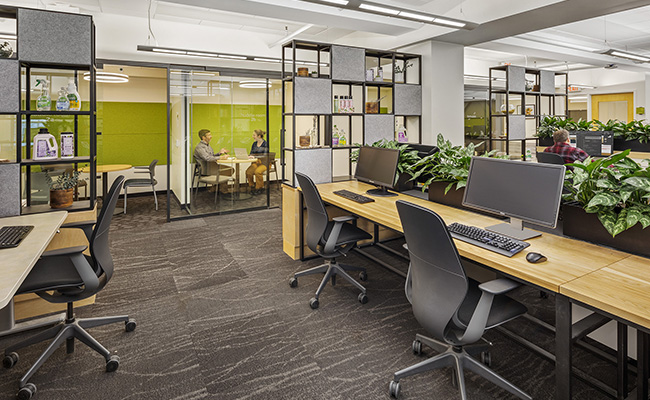
Enclosed huddle rooms, phone booths, and open scrum areas provide options for flexibility and collaboration. To compensate for the elimination of dedicated desk space, lockers are located throughout the office for the secure storage of personal items.
Proper circulation is also an important part of post-pandemic planning. At Seventh Generation, the walls surrounding the central atrium were opened, eliminating bottlenecks and improving connections to adjacent workspaces. This improved the connections between departments, while also allowing for safer, more socially distanced movement through the space.
A successful move to an agile workplace takes more than removing a few walls. It also requires a review of company policies and practices, and open communication with all stakeholders throughout the transition, known as Change Management.
At Seventh Generation, the move to an agile workplace was supported by a rigorous change management program. TruexCullins led an extensive programming and visioning process, working with representatives of all departments and senior leadership. We developed a program based on current needs and projected goals, utilizing a long list of resources, including research and guidelines by Unilever’s global workplace design team. A programming survey was administered company-wide to score workplace performance, employee experience, and to prioritize workplace features and services.
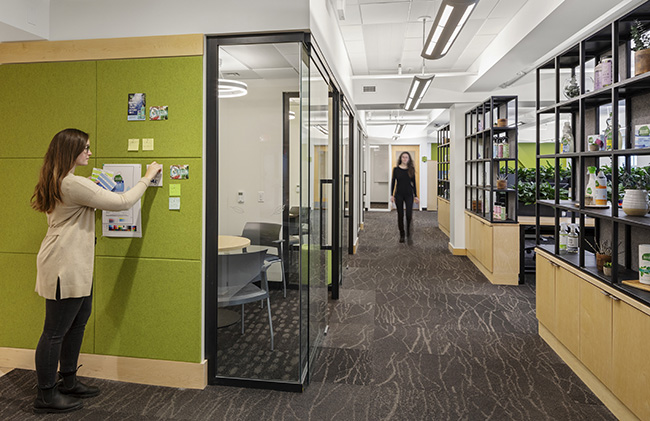
It’s true that most companies in and around Vermont are smaller, fewer than 200 people. An agile workplace works for them too.
Bigelow LLC is a mergers & acquisitions firm with fewer than 15 people. Formerly comprised of perimeter offices in a traditional, hierarchical layout, their workplace transformation introduced an agile concept in which all staff are free to use all aspects of the space at will. The private offices were removed and replaced with an open work zone with a stand-up worktable. Unassigned focus rooms flank the space, equipped with plug-and-play technology that makes it easy to drop-in on the fly.
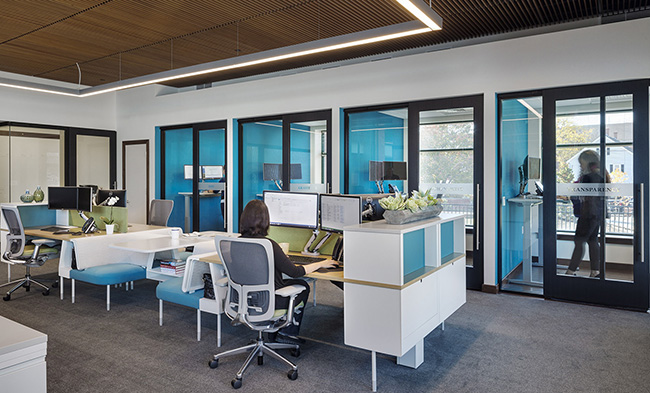
In a separate space, a café kitchen provides a relaxed environment for visitors and staff. The open lounge area is surrounded by meeting rooms of various sizes:
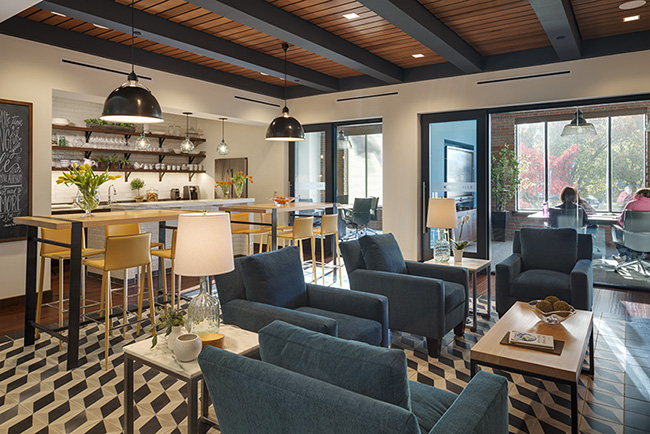
At only 3,100 square feet, the elimination of the private offices was key to providing enough space for all of these amenities. The number and variety of work zones increased, giving everyone greater freedom to move about the office and choose the best place to work.
WHY NOW?
In the early days of the pandemic, many workplace pundits were quick to write off the concept of the agile workplace – and the open office in general – claiming that its demise was imminent. They predicted workers would not want to share space with others, for fear of catching the virus. Open work areas would soon be replaced with rows of private offices.
These predictions were made in the days when we were wiping down our incoming mail and grocery boxes with disinfectant wipes. But we know a lot more about the transmission of the virus now. In May of 2020, the CDC issued a clarification that the virus is spread primarily by airborne particles, not by touching surfaces. Physical separation, social distancing, and masks are the main ways to prevent the spread. Sanitizing every surface was overkill.
Knowing this supports the concept of the agile workplace – giving people the ability to seek out less populated areas, for example, even if someone else was using the space 30 minutes prior.
Not every company will find it appropriate to move to a fully agile work environment, but moving forward, the general trend for everyone will be toward greater flexibility and autonomy.